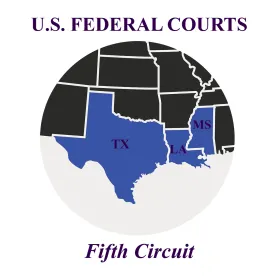In an important decision for employers defending collective actions under the FLSA, the U.S. Court of Appeals for the Fifth Circuit has declined to follow the two-step conditional certification-followed-by-decertification approach that is commonly followed by district courts across the country. The Fifth Circuit has jurisdiction over Louisiana, Mississippi, and Texas.
Under this so-called Lusardi approach that the
Fifth Circuit declined to follow, courts would often “conditionally certify” a collective (thus triggering notice to potential opt-in plaintiffs) without any true examination into whether those individuals were actually “similarly situated.” Due to an exceedingly low standard being applied at this first stage, plaintiffs’ counsel were almost guaranteed to win FLSA conditional certification even when the alleged violations required highly individualized analyses.
However, in Swales v. KLLM Transport Services, LLC, issued on January 12, 2021, the Fifth Circuit declined to follow the decades-old standard for conditionally certifying a FLSA collective. A three-member panel announced, “[A] district court must rigorously scrutinize the realm of ‘similarly situated’ workers, and must do so from the outset of the case, not after a lenient, step-one ‘conditional certification.’”
In so ruling, the appeals court made clear that district courts must review the factual record developed by the parties to determine whether plaintiffs meet the “similarly situated” standard before notice goes out to potential opt-in plaintiffs. Significantly, this holding rejects the commonplace doctrine that courts should avoid considering discovery at the conditional certification stage and assume the allegations in the plaintiffs’ complaint are valid.
Emergence of the two-step approach
Section 16(b) of the FLSA allows employees to proceed collectively when they are “similarly situated.” The statute, however, neither defines that term nor provides guidance as to how such actions may be brought. In 1989, the U.S. Supreme Court issued its landmark decision in Hoffmann-La Roche Inc. v. Sperling, in which the high court established the framework for collective actions and gave district courts discretion to send “accurate and timely notice” of pending actions to potential opt-in plaintiffs. While Hoffmann-La Roche involved Age Discrimination in Employment Act allegations, the collective action notice framework from the decision is cited most often today in FLSA cases.
Acknowledging the concerns expressed by Justice Antonin Scalia in his dissent, the Court majority made careful efforts to limit a district court’s authority to facilitate “accurate and timely notice” to “potential plaintiffs” who could opt-in and actually participate as plaintiffs in the collective action. The Court also made clear that federal courts maintain discretion to limit issuance of notice or decide not to issue any notice at all even if the plaintiffs demonstrated the putative collective was similarly situated.
The Court, however, did not provide clear guidance as to when it is proper to send notice of a case to opt-in plaintiffs. As a result, district courts across the country have grappled with this consequential issue, with many following a two-step process for “certification” set forth by a New Jersey district court in Lusardi v. Xerox Corporation in 1987. Significantly, neither Hoffmann-La Roche nor the FLSA itself makes any mention of a “certification” process.
Low bar for conditional certification.
The first step of the two-step certification process, referred to as “conditional certification” of a putative class, involves a district court’s determination of whether prospective opt-in plaintiffs are similar enough to receive notice of the pending lawsuit. During this initial step, courts have generally looked only to the pleadings and affidavits of the parties to decide — under a lenient standard — whether the plaintiffs are “similarly situated” to the employees they seek to represent and do not inquire into the actual merits of the allegations. Though some courts have conducted a more rigorous analysis and ruled that consideration of some discovery is appropriate, FLSA conditional certification is often granted with nothing more than boilerplate allegations that the putative class members have similar claims under the FLSA.
Post-discovery decertification.
It is only after the notices are sent to the potential opt-in plaintiffs and the parties have engaged in full discovery that an employer can move for “decertification” of the conditionally certified collective. At this second stage, a district court will utilize a stricter standard to determine whether the named plaintiffs and opt-ins are indeed sufficiently “similarly situated” to proceed to trial as a collective. Unfortunately for the employer, it has already been drawn into costly class-wide litigation and extensive discovery and may have been pressured into settling the matter regardless of the merits to end the dispute.
Fifth Circuit adopts more stringent framework
The Swales lawsuit was brought by truck drivers who claimed they were misclassified as independent contractors rather than as “employees” under the FLSA and unlawfully denied overtime compensation. After the parties engaged in substantial court-authorized discovery on “certification” issues, the plaintiffs moved for conditional certification. Following the two-step Lusardi approach, the district court granted the motion and conditionally certified a collective of “potentially thousands” of drivers, but also took the unique move of instantly certifying its decision for interlocutory appeal based on the “open questions regarding the applicable standards [of conditional certification], especially when some discovery has occurred.”
In granting conditional certification, the district court declined the employer’s bid to consider evidence allegedly showing the application of the economic-realities test to the plaintiffs and potential opt-ins would require a highly individualized inquiry. According to the Fifth Circuit, the lower court “believed it could not consider anything related to the economic-realities test at the pre-notice stage because the test was a ‘merits issue’ to be dealt with after discovery was complete.” However, the district court acknowledged the company “‘may ultimately have a point’ that, because each plaintiff would have to present different facts under the economic-realities test, they might not be ‘similarly situated.’”
“Gatekeeping” approach.
In deciding for the first time “the legal standard that district courts should use when deciding whether to send notice in an FLSA collective action,” the three-member panel of the Fifth Circuit addressed head-on the extent to which a district court may examine the factual circumstances of whether potential opt-in plaintiffs are “similarly situated” before conditionally certifying a collective action. The appeals court adopted a “definitive legal standard,” setting what it called a “gatekeeping” framework: assessing whether putative opt-in plaintiffs are similarly situated “before notice is sent to potential opt-ins ... not abstractly but actually.”
The Fifth Circuit observed that in hearing motions for conditional certification, district courts in the circuit have used “ad hoc tests of assorted rigor” in deciding whether employees are similarly situated. It described the standard the district court used in the case at hand as “a Goldilocks version of Lusardi, something in between lenient and strict.” But the appeals court wanted to adopt a more precise approach while expressly rejecting Lusardi — which it emphasized that it had “carefully avoided adopting” in the past. The problems the two-step certification standard creates “occur not at decertification, but from the beginning of the case,” the panel stressed. The panel stated, “The leniency of the stage-one standard, while not so toothless as to render conditional certification automatic, exerts formidable settlement pressure.” Two-stage certification “may be common practice,” the court noted. “But practice is not necessarily precedent.”
“Preliminary” discovery.
In order to determine whether it is appropriate to send notice to potential opt-in plaintiffs, the Fifth Circuit instructed district courts to “identify, at the outset of the case, what facts and legal considerations will be material to determining whether a group of ‘employees’ is ‘similarly situated,’” and then “authorize preliminary discovery accordingly.” The amount of discovery necessary to make this determination will vary case by case and may in certain circumstances include issues that go to the merits of the case. “The fact that a threshold question is intertwined with a merits question does not itself justify deferring those questions until after notice is sent out,” the appeals court explained. “When a district court ignores that it can decide merits issues when considering the scope of a collective, it ignores the ‘similarly situated’ analysis and is likely to send notice to employees who are not potential plaintiffs. In that circumstance, the district court risks crossing the line from using notice as a case-management tool to using notice as a claims-solicitation tool.”
Applying this new standard to the instant case, the Fifth Circuit explained the district court should have considered the evidence relating to how much control the employer had over the truck drivers “in order to determine whether the economic-realities test could be applied on a collective basis.” If it had done so, the district court may have concluded the opt-ins were “too diverse a group to be ‘similarly situated’ for purposes of answering whether they are in fact employees, or at least that Plaintiffs have not met their burden of establishing similarity.” Alternatively, the district court may have determined that only certain subcategories of drivers should receive notice as opposed to the entire group of drivers the plaintiff sought to represent.
What now?
The immediate effect of the Swales decision on FLSA collective actions is that (at least for litigation brought in the Fifth Circuit) plaintiffs no longer will be able to issue notice to potential opt-in plaintiffs based merely on the allegations raised in the complaint. Instead, the district court must decide what discovery is warranted to make the threshold determination as to whether plaintiffs are actually “similarly situated” to the collective they purport to represent. As a result, employers will be able to gain more information about the extent of a potential class early in the case, thereby allowing it to make important strategic decisions at an earlier stage of litigation, rather than having to wait until it can move to decertify a class.
Moreover, district courts outside the Fifth Circuit may be persuaded to adopt the new framework, or something more like it. At the very least, district courts will be asked to address the question of whether to adopt the new alternative approach, and those who explicitly choose not to do so will eventually create a conflict between the circuits ripe for Supreme Court review. In the meantime, at least within the Fifth Circuit, courts should apply a fairer, more workable framework for evaluating whether potential opt-in plaintiffs are similarly situated before conditional certification is granted.
Open questions.
Swales leaves many questions unanswered that district courts both within and outside the Fifth Circuit are sure to grapple with for years to come. Perhaps most significantly, the decision begs the issue of whether decertification motions will continue to play a role in FLSA collective cases (at least in the Fifth Circuit), or if they will take a different form with a different level of scrutiny. If courts are to determine whether plaintiffs satisfy the “similarly situated” standard in order for notice to be issued using a standard akin to that for traditional class actions under Federal Rule of Civil Procedure 23, with its “well-established procedural safeguards to ensure that the named plaintiffs are appropriate class representatives,” FLSA Sec. 216(b) certification may become a single-step, definitive determination.
The predicament: statute of limitations
The new requirement in the Fifth Circuit of preliminary discovery also raises an important issue that is not present in the Rule 23 class action context: the pre-certification running of the statute of limitations pending discovery. Unlike Rule 23 class litigation, where the statute of limitations is tolled at the time the original complaint is filed, for FLSA collective actions the statute of limitations is not tolled until an opt-in plaintiff files the requisite consent form. As a result, when faced with a FLSA collective action, an employer is incentivized to oppose conditional certification much earlier in the case, in hopes of running out the clock before a collective is certified. For the same reasons, plaintiffs are disincentivized to permit any delay of their certification efforts to allow for any type of discovery, to prevent the claims of any potential opt-in plaintiffs from being time-barred.
Now that district courts in the Fifth Circuit have been instructed to conduct preliminary discovery at the notice stage, plaintiffs are at much higher risk of having the statute of limitations run for the potential opt-in plaintiffs. Consequently, they likely will seek a tolling agreement. However, even if such an agreement cannot be mutually agreed upon between the parties, a district court may also exercise its discretion to toll the statute of limitations to allow the parties to engage in the now-required discovery.
Tolling agreements.
Since the statute of limitations does not stop running for a particular member of the collective until that employee files an opt-in notice, a direct correlation exists between early class notice and higher litigation costs and ultimate verdicts. As a result, even in courts outside the Fifth Circuit, employers should discuss with counsel the advantages of consenting to a tolling agreement with plaintiffs’ counsel in exchange for pre-certification discovery. A tolling agreement in exchange for preliminary discovery will allow an employer to potentially save money and resources by limiting the size of the collective, or fending off certification altogether, while plaintiffs’ counsel will benefit by knowing that if the court is persuaded to issue notices to potential opt-ins, their claims will not be time-barred.






 />i
/>i
